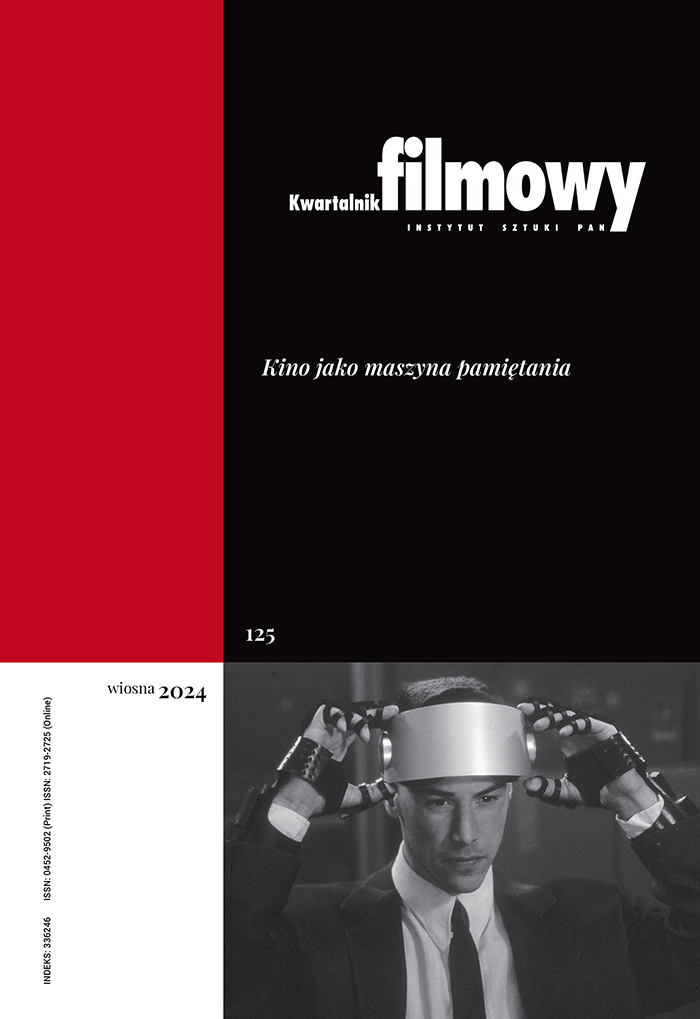Early Work of Zhang Yimou and the Art That Inspired It
Abstract
We are used to the fact that an artist, being representative of a given culture, will use that tradition, the patterns of native painting and visual symbolic representation as a resource and inspiration in his or her film making. However a problem arises, when we consider the relationship between art coming from “different” cultural sphere and Western culture, where the art of film making was born. Helman writes about the incompatibility of the traditional Chinese system of representation with the system one inherited by film makers, with its roots in the culture of Renaissance. The author describes the rules present in Chinese painting (especially landscape painting) and their relation to Tao and Confucianism, and then considers whether these rules could be applied in film making. She bases her analysis on the early work of Zhang Yimou, an artist whose work is on the one hand deeply grounded in the Chinese tradition, but on the hand unique and escaping simple classification.
Keywords:
Zhang Yimou, Chinese cinema, paintingReferences
Ān Jĭngfū, The Pain of a Half Taoist: Taoist Principles, Chinese Landscape Painting, and „King of the Children”, w: Cinematic Lanscapes, red. L. C. Ehrlich, D. Desser, University of Texas Press, Austin 1994, s. 119-120.
Google Scholar
Berry Chris, Mary Ann Farquhar, Post-Socialist Strategies: An Analysis of „Yellow Earth” and „Black Cannon Incident”, w: Cinematic Lanscapes, red. L. C. Ehrlich, D. Desser, University of Texas Press, Austin 1994, s. 85.
Google Scholar
Hăo Dázhēng, Chinese Visual Representation: Painting and Cinema, w: Cinematic Lanscapes, red. L. C. Ehrlich, D. Desser, University of Texas Press, Austin 1994, s. 46-47, 60.
Google Scholar
Jiao Xiongping, Discussing „Red Sorghum”, w: Zhang Yimou Interwievs, red. F. Gateward, University Press of Mississippi, Jackson 2001, s. 6.
Google Scholar
Kwok Wah Lau Jenny, An Experiment in Color and Portraiture in Chinese Cinema, w: Cinematic Lanscapes, red. L. C. Ehrlich, D. Desser, University of Texas Press, Austin 1994.
Google Scholar
Mikrut Agnieszka, Transgresja w twórczości Zhanga Yimou (maszynopis pracy magisterskiej w archiwum Instytutu Sztuk Audiowizualnych Uniwersytetu Jagiellońskiego), s. 56.
Google Scholar
Nĭ Zhén, Classical Chinese Painting and Cinematographic Signification, w: Cinematic Lanscapes, red. L. C. Ehrlich, D. Desser, University of Texas Press, Austin 1994, s. 64, 66, 72-74.
Google Scholar
Silbergeld Jerome, China into Film. Frames of Reference in Contemporary Chinese Cinema, Reaktion Books, London 1999.
Google Scholar
Wilkerson Douglas, Film and the Visual Arts in China: An Introduction, w: Cinematic Lanscapes, red. L. C. Ehrlich, D. Desser, University of Texas Press, Austin 1994, s. 43
Google Scholar
Authors
Alicja Helmankwartalnik.filmowy@ispan.pl
Jagiellonian University Poland
Filmoznawca, wykłada w Instytucie Sztuk Audiowizualnych na UJ. Autorka m.in: Słownik pojęć filmowych (1991-1998), Historia semiotyki filmu, t. 1-2 (1992-1993), Twórcza zdrada. Filmowe adaptacje literatury (1998), Urok zmierzchu. Filmy Luchina Viscontiego (2002), Ten smutek hiszpański. Konteksty twórczości filmowej Carlosa Saury (2005).
Statistics
Abstract views: 430PDF downloads: 49
License
Copyright (c) 2009 Alicja Helman

This work is licensed under a Creative Commons Attribution 4.0 International License.
The author grants the publisher a royalty-free non-exclusive licence (CC BY 4.0) to use the article in Kwartalnik Filmowy, retains full copyright, and agrees to identify the work as first having been published in Kwartalnik Filmowy should it be published or used again (download licence agreement). The journal is published under the CC BY 4.0 licence. By submitting an article, the author agrees to make it available under this licence.
In issues from 105-106 (2019) to 119 (2022) all articles were published under the CC BY-NC-ND 4.0 licence. During this period the authors granted a royalty-free non-exclusive licence (CC BY-ND 4.0) to use their article in „Kwartalnik Filmowy”, retained full copyright, and agreed to identify the work as first having been published in our journal should it be published or used again.
Most read articles by the same author(s)
- Alicja Helman, Not in the Canon, but at the Centre of Matters , Kwartalnik Filmowy: No. 79 (2012): Interiors: On Cinematic Enclosed Space
- Alicja Helman, In Search of Meaning , Kwartalnik Filmowy: No. 87-88 (2014): Film and Theatre
- Alicja Helman, Cultural Contexts of Glauber Rocha’s Filmmaking , Kwartalnik Filmowy: No. 103 (2018): Young Polish Cinema – Confrontation of Generations
- Alicja Helman, Transgressions and Transformations in the Filmmaking of Kornél Mundruczó , Kwartalnik Filmowy: No. 101-102 (2018): European Cinema of 21st Century
- Alicja Helman, À Propos Realism , Kwartalnik Filmowy: No. 75-76 (2011): Faces of Reality
- Alicja Helman, Rick Altman’s Theory of Narrative , Kwartalnik Filmowy: No. 71-72 (2010): Narration in Film
- Alicja Helman, The Paths of Film Studies Development , Kwartalnik Filmowy: No. 85 (2014): Film and Media – the Past and the Future
- Alicja Helman, Difficult Development of Unused Potential , Kwartalnik Filmowy: No. 103 (2018): Young Polish Cinema – Confrontation of Generations
- Alicja Helman, The Country Cinema of Zhang Yimou , Kwartalnik Filmowy: No. 51 (2005): Film in Asia
- Alicja Helman, Towards Synthesis , Kwartalnik Filmowy: No. 69 (2010): History in Film
Similar Articles
- Jerome Silbergeld, The Children of Melodrama: No-drama, Pseudo-drama, Melodramatic Masquerade and Deconstruction Drama (part I) , Kwartalnik Filmowy: No. 51 (2005): Film in Asia
- Jerome Silbergeld, The Children of Melodrama: No-drama, Pseudo-drama, Melodramatic Masquerade and Deconstruction Drama (part II) , Kwartalnik Filmowy: No. 52 (2005): British Cinema (part I)
You may also start an advanced similarity search for this article.











